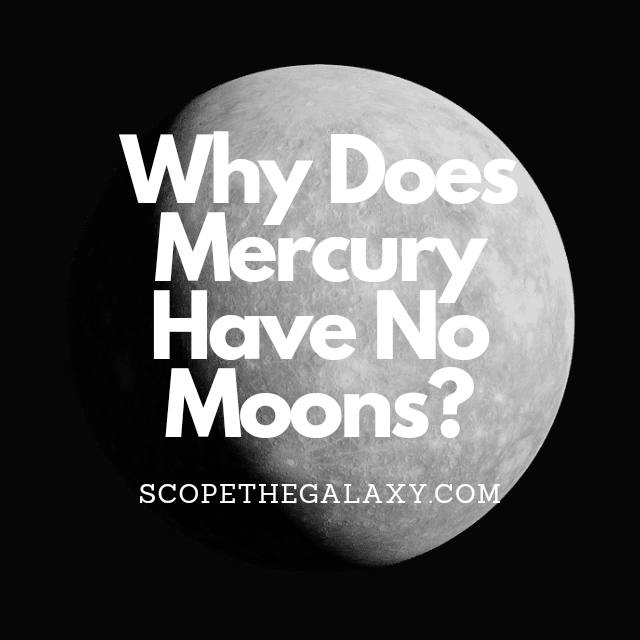*This post may contain affiliate links. This means we may make a commission if you purchase an item using one of our links*
Mercury has no moons because its proximity to the Sun makes this feat near impossible. Mercury probably did possess its own moon at some stage, but it could never provide a stable enough gravity to maintain this type of satellite.
Continue reading to find out if a moon could ever orbit Mercury, plus the reasons why. And discover what factors help to create and sustain a moon.
Did Mercury Ever Have A Moon?
Table of Contents
Mercury would likely have possessed a moon at some point in time, but due to the Sun and other factors, this moon would have been pulled from the planet’s orbit.
If we look at the relationship between Earth and its Moon, we see that there are two tidal bulges; one from the force of attraction and the other from inertia. Over time, this has caused our moon to become tidally locked to the Earth, yielding slightly more of a pull to the front side.
And this pull gives the moon a slow acceleration, resulting in it moving away from Earth at a rate of around 3cm per year.
However, if the Earth had a slower spin rate, the bulge would sit behind the moon because the moon would orbit at a faster rate than the planet’s spin. Over time, this would slow the natural satellite down, causing the moons to fall to the surface.
If Mercury ever did have a moon, this could be one possible reason why it ceased to exist. The other reason would be due to the severe gravitational pull of the Sun.
Could Mercury Ever Get A Moon Orbiting It?

There are three common ways for a planet to obtain a moon: the first, a circumplanetary disc transforms into a larger body or satellite. If this body gains enough mass, it may possess the gravity to form a spherical shape.
The second is that a larger body captures a smaller body in its gravitational field. And the final way is that something collides with the planet – many scientists believe that this is how Earth came to host its own moon.
A large enough collision can cause a planet to eject vast amounts of material into space, which then merge to form a moon.
Of all the planets in the solar system, Mercury would have the most challenging time sustaining a moon; there are several reasons why this is virtually impossible.
First of all, the planet’s close proximity to the Sun means that any body in its orbit would likely be captured and destroyed by the Sun. In addition, Mercury’s small size and mass would make it challenging to generate enough energy to hold a moon in its gravity.
Plus, Mercury rotates relatively slowly. When we look at Earth and Mars, both planets make a full rotation in 24-25 hours. However, Mercury takes 1,416 hours, or the equivalent of 59 Earth days. And this slow rotation dramatically impacts the stability of a moon.
Mercury could pull a moon into orbit, but it would be very unlikely to remain there for longer than a few million years
How Does The Sun Not Allow Moons To Orbit Mercury?
Mercury’s orbit around the Sun is egg-shaped, which gives it a varied distance from the Sun, ranging from 46 million to 70 million kilometers.
Being so close to the Sun makes it almost impossible for Mercury to possess any moons, as the gravitational pull of our vast star would soon pull them from the planet’s orbit. A moon that did fall into the orbit of Mercury would likely crash into the planet or find itself drawn into a solar orbit (later being entirely engulfed by the Sun).
A moon sitting too far from Mercury wouldn’t possess enough gravity for a stable orbit, facing its fate as a captive of the Sun. In contrast, a moon that orbited too close to Mercury would experience strong tidal gravities, ultimately destroying them.
One feature of the gravitational parameters between the Sun and the Earth is the Hill Sphere, the region around each planet that has the perfect mix of gravitational parameters to host a moon.
The Hill sphere around Earth has a radius of approximately 1.5km, but the radius of their Hill Sphere decreases for planets that more closely orbit the Sun. For Venus, the Hill sphere sits around 1km, while Mercury’s Hill sphere has a tiny radius of only 0.175km.
This means the band where a moon could hold a stable orbit is very slim.
Summary
Mercury could pull a moon into its orbit, but it would have a tough time trying to keep it there. A combination of low mass, a slow spin rate, and a tiny Hill Sphere mean that the moon will eventually be forced towards the Sun’s gravity or drop back down striking Mercury in the process.
References
The Mystery to Why Don’t Mercury and Venus Have No Moons? – Moon Crater Tycho
Why Don’t Mercury And Venus Have Moons? – WorldAtlas
How many moons does Mercury have? (Update) (phys.org)

